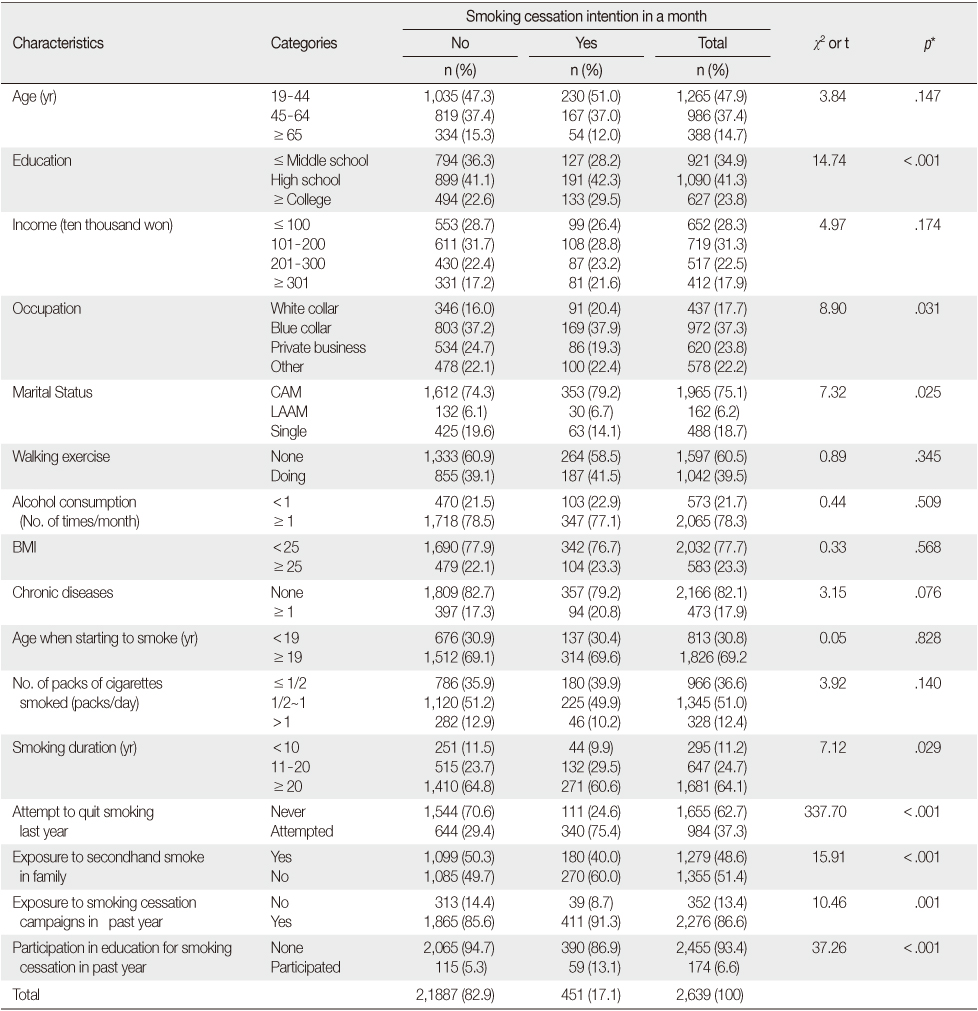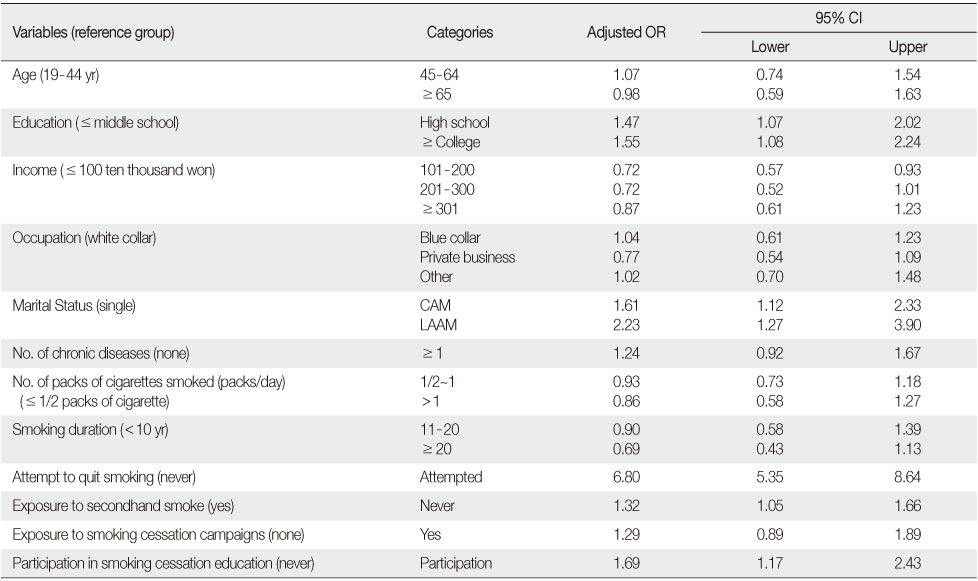Articles
- Page Path
- HOME > J Korean Acad Nurs > Volume 42(3); 2012 > Article
-
Original Article
- Factors Affecting Preparation Stage to Quit Smoking in Men
- Jeong-Woon Yeon, Hyeongsu Kim, Kunsei Lee, Sounghoon Chang, Heejung Choi, Eunmi Ham, Jun Pyo Myong
-
Journal of Korean Academy of Nursing 2012;42(3):377-384.
DOI: https://doi.org/10.4040/jkan.2012.42.3.377
Published online: June 29, 2012
1Researching Nurse, Department of Preventive Medicine, School of Medicine, Konkuk University, Seoul, Republic of Korea.
2Professor, Department of Preventive Medicine, School of Medicine, Konkuk University, Seoul, Republic of Korea.
3Professor, Department of Nursing, College of Biomedical and Health Sciences, Konkuk University, Chungju, Republic of Korea.
4Clinical Fellow, Department of Preventive Medicine, Catholic Industrial Medical Center, College of Medicine, The Catholic University of Korea, Seoul, Republic of Korea.
- Address reprint requests to: Kim, Hyeongsu. Department of Preventive Medicine, School of Medicine, Konkuk University, 1 Hwayang-dong, Gwangjin-gu, Seoul 143-701, Korea. Tel: +82-2-2030-7942, Fax: +82-2-2049-6192, mubul@kku.ac.kr
© 2012 Korean Society of Nursing Science
- 638 Views
- 0 Download
- 6 Crossref
Abstract
-
Purpose
- This study was done to investigate factors affecting preparation stage to quit smoking in men.
-
Methods
- Based on data from the Community Health Survey conducted in Chungbuk Province in 2008, we estimated rates and odds ratio (OR) of smoking cessation intention for 2,639 men who were current smokers. Multivariate logistic regression analyses were used to identify factors affecting preparation stage to quit smoking.
-
Results
- Among current male smokers, the rate of smoking cessation intention was 17.1%. The OR of factors affecting smoking cessation was as follows: Compared to men with middle school education, the OR for rate of smoking cessation intention in men with high school education was 1.47 (p=.018), and for college or higher, 1.55 (p=.017). Compared to being single, the OR for cohabitation after marriage was 1.61 (p=.011) and living alone after marriage, 2.23 (p=.005). The OR for attempt to quit smoking, exposure to secondhand smoke and participation in smoking education were 6.80 (p<.001), 1.32 (p=.020) and 1.69 (p=.005), respectively.
-
Conclusion
- Results of this study show that it is necessary to decrease exposure to secondhand smoke and to increase participation in smoking cessation education targeting current smokers to move them from precontemplation or contemplation stage to preparation stage.
- 1. Ahn OH, Yeun EJ, Kwon SB, Chung HK, Ryu EJ. Predictive factors of aspects of the transtheoretical model on smoking cessation in a rural community. Journal of Korean Academy of Nursing. 2005;35:1285–1294.ArticlePubMedPDF
- 2. Chang HJ, Noh MS. Factors related to the recognition and behavioral intention for smoking cessation programs. Korean Journal of Health Education and Promotion. 2003;20(3):1–18.
- 3. Chang SO, Kim EJ, Kil SY, Seomun GA, Lee SJ. Influential variables on intention and action to quit smoking between adolescent smokers and adult smokers-based on the transtheoretical model. Journal of Korean Academy of Nursing. 2005;35:1410–1419.ArticlePubMedPDF
- 4. Chang SO, Kim EJ, Seomun GA, Lee SJ, Cha BK. Predictors of pre and post preparation in stages of change of smoking for adolescent smokers and adult smokers. Journal of Korean Academy of Fundamentals of Nursing. 2006;13:119–128.
- 5. Chang SO, Park CS. A study on the variables that influence stages of change in smoking cessation. Journal of Korean Academy of Fundamentals of Nursing. 2001;8:391–401.
- 6. Kenford SL, Flore MC, Jorenby DE, Smith SS, Wetter D, Baker TB. Pridicting smoking cessation. Who will quit with and without the nicotine patch. Journal of the American Medical Association. 1994;271:589–594.PubMed
- 7. Kim BJ. Factors associated with stages of change of smoking cessation behavior in military officers. 2000;Seoul, Yonsei University. Unpublished master's thesis.
- 8. Kim MS. A study on health-related quality of life, smoking knowledge, smoking attitude, and smoking cessation intention in male smokers. Journal of Korean Academy of Nursing. 2005;35:344–352.ArticlePubMedPDF
- 9. Kim YH, Kim JS, Kim MS. Effectiveness of public health center smoking cessation counseling program using the transtheoretical model. Journal of Korean Academy of Nursing. 2009;39:469–479. http://dx.doi.org/10.4040/jkan.2009.39.4.469.ArticlePubMed
- 10. Kim YH, Seo NS, Kang HY. Nicotine dependence, smoking-related attitude, and subjective norms across the stages of change for smoking cessation among adults smokers in a rural area. Journal of Korean Academy of Nursing. 2006;36:1023–1032.ArticlePubMedPDF
- 11. Lee HJ. Self-efficacy and smoking behavior according to the stage of change in smoking cessation. 2007;Incheon, Gachon University. Unpublished master's thesis.
- 12. Manchón Walsh P, Carrillo P, Flores G, Masuet C, Morchon S, Ramon JM. Effects of partner smoking status and gender on long term abstinence rates of patients receiving smoking cessation treatment. Addictive Behaviors. 2007;32:128–136. http://dx.doi.org/10.1016/j.addbeh.2006.03.027.ArticlePubMed
- 13. Marcus BH, Selby VC, Niaura RS, Rossi JS. Self-efficacy and the stages of exercise behavior change. Research Quarterly for Exercise and Sport. 1992;63:60–66.ArticlePubMed
- 14. Ministry for Health, Welfare and Affairs. A survey of smoking behavior in 2010. 2011a;04 30 Retrieved April 30, 2011. from http://www.nosmokeguide.or.kr/policy/policy4_02_list.asp?idx_no=273&searchkey=&search=&gotopage=1&pds_code=S.
- 15. Ministry for Health, Welfare and Affairs. Information system of smoking cessation clinic at Public Health Center. 2011b;08 02 Retrieved August 2, 2011. from http://quitclinic.nosmokeguide.or.kr/login/login.asp.
- 16. Konkuk University, Korea Centers for Disease Control & Prevention. 2008 community health survey in Chungbuk-do. 2009;04;Chungju, Author.
- 17. Pechmann C, Reibling ET. Planning an effective anti-smoking mass media campaign targeting adolescents. Journal of Public Health Management and Practice : JPHMP. 2000;6(3):80–94.ArticlePubMed
- 18. Prochaska JO, DiClimente CC, Norcross JC. In search of how people change. Applications to addictive behaviors. American Psychologist. 1992;47:1102–1114. http://dx.doi.org/10.1037//0003-066-X.47.9.1102.ArticlePubMed
- 19. Plummer BA, Velicer WF, Redding CA, Prochaska JO, Rossi JS, Pallonen UE, et al. Stage of change, decisional balance, and temptations for smoking: Measurement and validation in a large, school-based population of adolescents. Addictive Behaviors. 2001;26:551–571. http://dx.doi.org/10.1016/S0306-4603(00)00144-1.Article
- 20. Ryu SY, Shin JH, Kang MG, Park J. Factors associated with intention to quit smoking among male smokers in 13 communities in Honam region of Korea: 2010 community health survey. Korean Journal of Health Education and Promotion. 2011;28:75–85.
- 21. Sheeran P. Intention-behavior relations: A conceptual and empirical review. European Review of Social Psychology. 2002;12(1):1–36. http://dx.doi.org/10.1080/14792772143000003.Article
- 22. Son JH, Kim SA, Kam S, Yeh MH, Park KS, Oh HS. Factors related to the intention of participation in a worksite smoking cessation program. Journal of Preventive Medicine and Public Health. 1999;32:297–305.
- 23. Suh MK. The conditions and analysis of anti-smoking campaign of governmental offices in 2005. 2006;05;In: Symposium conducted at the meeting of the 2006 Spring Conference of Korean Society of Health Education and Promotion; Seoul.
REFERENCES
Figure & Data
REFERENCES
Citations

- Association between having a meal together with family and smoking: a cross-sectional nationwide survey
Gun Hee Cho, Yun Seo Jang, Jaeyong Shin, Chung-Mo Nam, Eun-Cheol Park
BMC Public Health.2023;[Epub] CrossRef - The association of stage of change for smoking cessation with smoking knowledge and attitude in women college students of Seoul, Korea
Haena Kim, Kang-Sook Lee, Yeji Lee, Eunji Cho, Kyung Min Kim
Korean Journal of Health Education and Promotion.2019; 36(1): 69. CrossRef - Factors Affecting Smoking Cessation Intention of Female Workers: Using Community Health Survey, 2014
Hye-Young Jang, Song Yi Han
Korean Journal of Occupational Health Nursing.2016; 25(4): 352. CrossRef - Exploring socio-contextual factors associated with male smoker’s intention to quit smoking
Minsoo Jung
BMC Public Health.2016;[Epub] CrossRef - Predictors of Intention to Quit Smoking in Elderly Smokers following a Stroke
Eun Su Do, Young-Sook Seo
Journal of Korean Academy of Fundamentals of Nursing.2014; 21(1): 48. CrossRef - Integrative Smoking Cessation Stage Model for Chinese Students Studying in Korea
Hyunsoo Oh, Hyesun Jeong, Whasook Seo
Asian Nursing Research.2013; 7(4): 182. CrossRef
Smoking Cessation Intention by Demographic, Health-related, Smoking-related and Environmental Factors
BMI=Body mass index; CAM=Cohabitation after marriage; LAAM=Living alone after marriage.
*Fisher's exact test.
Logistic Regression Analysis for Smoking Cessation related Variables
OR=Odds ratio; CI=Confidence interval; CAM=Cohabitation after marriage; LAAM=Living alone after marriage.
BMI=Body mass index; CAM=Cohabitation after marriage; LAAM=Living alone after marriage. *Fisher's exact test.
OR=Odds ratio; CI=Confidence interval; CAM=Cohabitation after marriage; LAAM=Living alone after marriage.
 KSNS
KSNS
 E-SUBMISSION
E-SUBMISSION


 Cite
Cite

